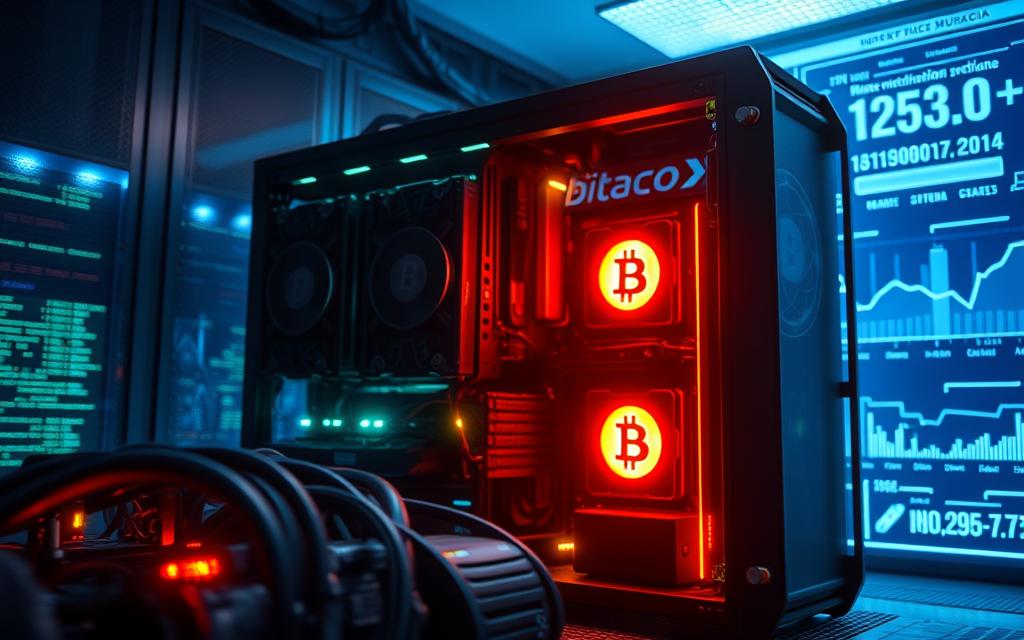Table of Contents
Bitcoin mining is a complex process that involves solving intricate mathematical problems to validate transactions on the blockchain. The miners compete to solve these problems, and the first to do so is rewarded with newly minted Bitcoins.
The block reward is currently set at 3.125 BTC, and a new block is mined approximately every 10 minutes. However, this doesn’t directly translate to the time it takes to mine 1 Bitcoin, as the reward is significantly more than one Bitcoin. The time it takes is influenced by factors such as the efficiency of a miner’s hardware and the overall network difficulty.
The mining process is probabilistic, making it challenging to predict exactly when one will mine a Bitcoin. For most individual miners, mining a full Bitcoin independently is highly challenging due to the competitive nature of the process.
Understanding Bitcoin Mining Basics
The foundation of Bitcoin’s decentralized system lies in its mining process, which is both intricate and fascinating. Bitcoin mining is a critical component that ensures the integrity and security of the Bitcoin network.
What is Bitcoin Mining?
Bitcoin mining involves validating transactions and adding them to the public ledger known as the blockchain. Miners compete to solve complex cryptographic puzzles, which require significant computational power. The first miner to solve the puzzle gets to add a new block of transactions to the blockchain and is rewarded with newly minted Bitcoins and transaction fees. For a detailed explanation of how Bitcoin mining works, you can visit Investopedia’s guide on Bitcoin mining.
The Role of Miners in the Bitcoin Network
Miners play a crucial role in maintaining the Bitcoin network‘s integrity and functionality. They act as validators who confirm transactions, package them into blocks, and add those blocks to the blockchain after solving the required cryptographic puzzle. By doing so, miners contribute to the security of the network by making it computationally expensive to attack or manipulate the blockchain. Miners receive two types of rewards: newly minted Bitcoins (block rewards) and transaction fees from users wanting their transactions processed.
How Long Does It Take to Mine 1 Bitcoin?
To grasp how long it takes to mine 1 Bitcoin, one must first understand the basics of block rewards and mining difficulty. The Bitcoin mining process is complex, involving the solving of intricate mathematical problems to validate transactions on the blockchain.
The 10-Minute Block Time Explained
The average time to mine a block is approximately 10 minutes. This duration is not directly related to mining 1 Bitcoin but rather to mining a block, which currently rewards 3.125 BTC. The 10-minute block time is a design feature of the Bitcoin protocol, aimed at maintaining a consistent rate of block creation.

Block Rewards vs. Mining a Full Bitcoin
The block reward is the amount of Bitcoin awarded to miners for successfully mining a block. Currently, this reward is 3.125 BTC per block. For an individual miner, the time to mine 1 Bitcoin depends on their share of the total network hash rate. A miner with a small percentage of the network’s hash power may need months or years to mine a full Bitcoin independently. Miners typically calculate their earnings in fractions of Bitcoin over time rather than counting the time to mine one full coin.
Mining a single Bitcoin can take a considerable amount of time, influenced by factors such as the miner’s hardware and the overall network hash rate. Understanding these dynamics is crucial for miners to assess their potential returns on investment.
Key Factors Affecting Bitcoin Mining Time
Several factors play a crucial role in determining how long it takes to mine Bitcoin. Understanding these elements is essential for miners to optimize their operations and maximize their earnings.
Network Hash Rate
The network hash rate is a critical factor that affects Bitcoin mining time. It refers to the total computational power being used by miners to validate transactions and mine new Bitcoins. A higher network hash rate indicates a more secure network but also increases the difficulty of mining.
The current network hash rate is a key indicator of the overall health and security of the Bitcoin network.
Mining Difficulty
Mining difficulty is another crucial factor that influences Bitcoin mining time. It is adjusted every 2016 blocks, or approximately every two weeks, to maintain a consistent block time of around 10 minutes. A higher mining difficulty means that miners need more powerful hardware to solve the complex mathematical equations required to mine Bitcoins.
Your Mining Hardware’s Hash Power
The hash power of your mining hardware significantly impacts your ability to mine Bitcoins efficiently. Miners with more powerful hardware, such as ASICs (Application-Specific Integrated Circuits), have a higher chance of solving the mathematical equations and earning Bitcoins.
| Mining Hardware | Hash Rate | Energy Efficiency |
|---|---|---|
| Antminer S19 Pro | 110 TH/s | 29.5 J/TH |
| Whatsminer M30S++ | 112 TH/s | 31 J/TH |
Mining Hardware and Its Impact on Mining Speed
Mining hardware plays a crucial role in determining the efficiency of Bitcoin mining operations. The type of hardware used can significantly impact the speed at which miners can mine Bitcoin.
ASIC Miners vs. GPUs vs. CPUs
The landscape of Bitcoin mining hardware has evolved significantly, with ASIC (Application-Specific Integrated Circuit) miners becoming the norm due to their high hash rates and efficiency. Unlike GPUs (Graphics Processing Units) and CPUs (Central Processing Units), ASIC miners are designed specifically for cryptocurrency mining, offering superior performance. For instance, the Antminer S19, a well-known ASIC miner, boasts a hash rate of about 95 TH/s. GPUs, once popular for mining, are now less competitive due to their lower hash rates and higher energy consumption. CPUs are the least efficient and are no longer viable for Bitcoin mining.
Latest Mining Hardware Performance Metrics
The latest mining hardware models have shown remarkable improvements in performance. For example, the S21Hyd model achieves a hash rate of 335 TH/s, significantly outperforming older models. The table below compares the performance metrics of some of the latest ASIC miners:
| Model | Hash Rate (TH/s) | Power Consumption (W) | Efficiency (J/TH) |
|---|---|---|---|
| Antminer S21Hyd | 335 | 5360 | 16 |
| Antminer S19 | 95 | 3250 | 34.2 |
| Whatsminer M30S++ | 112 | 3472 | 31 |
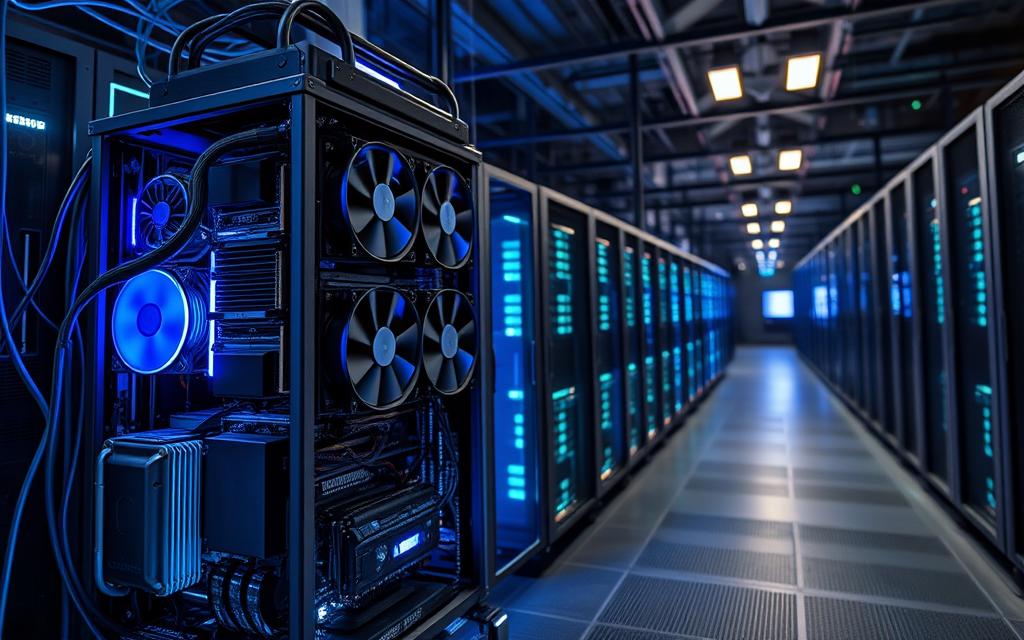
The data indicates that newer models not only offer higher hash rates but also improved energy efficiency, which is crucial for reducing operational costs. As the Bitcoin network continues to evolve, the demand for more efficient mining hardware will likely increase.
Solo Mining vs. Pool Mining
The decision to mine solo or join a pool is crucial for Bitcoin miners, affecting their potential earnings and mining experience. Bitcoin mining can be done individually, known as solo mining, or collectively through mining pools.
The Challenges of Solo Mining
Solo mining involves a single miner attempting to solve the complex mathematical equations required to mine Bitcoin. This approach can be challenging due to the high level of competition and the significant computational power required. Solo miners must have substantial resources to compete with large mining operations.
How Mining Pools Distribute Bitcoin Rewards
Mining pools, on the other hand, allow multiple miners to combine their resources, increasing their collective chances of mining Bitcoin. The rewards are then distributed among pool members based on their contributed hash power. Different pools use various reward distribution methods, including proportional, pay-per-last-N-shares, and pay-per-share.
| Reward Distribution Method | Description |
|---|---|
| Proportional | Rewards are distributed based on the miner’s hashrate contribution. |
| Pay-per-last-N-shares | Miners are paid based on their time on “shift.” |
| Pay-per-share | Miners receive a fixed income for contributing a certain amount of hashrate daily. |
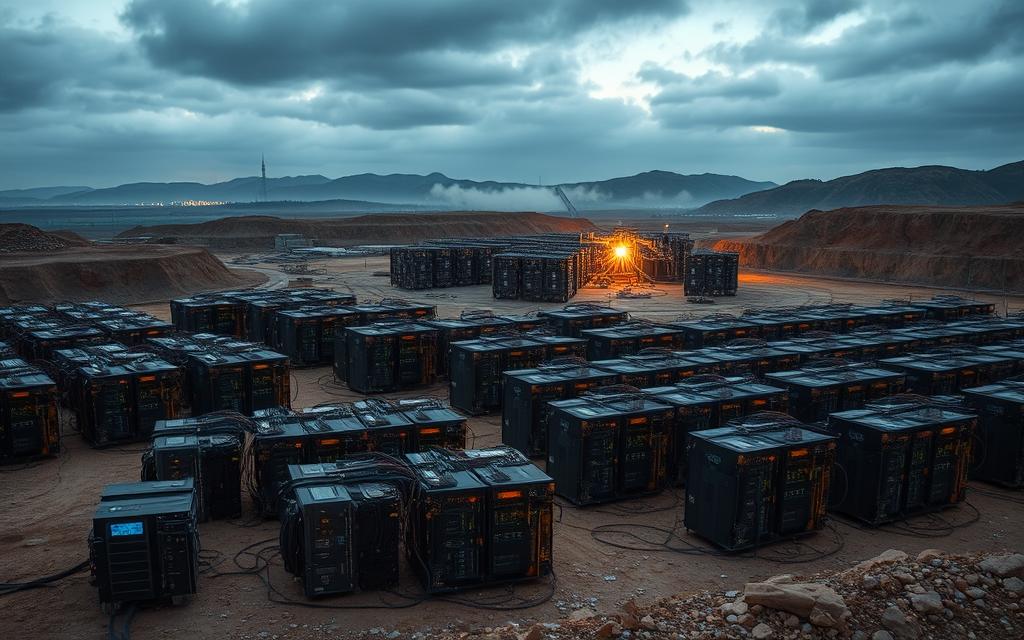
By joining a mining pool, miners can enjoy a more predictable income stream, although pool fees typically range from 1-3%. The choice between solo and pool mining depends on a miner’s resources, risk tolerance, and financial goals.
Bitcoin Mining Difficulty Adjustment
The Bitcoin protocol includes a mechanism to adjust mining difficulty to maintain a consistent block time. This adjustment occurs every 2016 blocks, or approximately every two weeks, based on the total hash rate of the network.
How Difficulty Adjustments Work
The difficulty adjustment is made to ensure that the block time remains around 10 minutes. If the total network hash rate increases, indicating more miners are active, the difficulty adjusts upward to maintain the 10-minute target. Conversely, if the hash rate decreases, the difficulty adjusts downward, making it easier for the remaining miners to find blocks.
Historical Trends in Mining Difficulty
Historically, mining difficulty has generally increased over time as more miners join the network and the hash rate grows. However, there have been notable exceptions during market downturns, such as in 2018 and 2022, when difficulty dropped due to decreased mining activity. The adjustment mechanism ensures that the time to mine a block remains relatively stable despite fluctuations in the network’s hash rate.
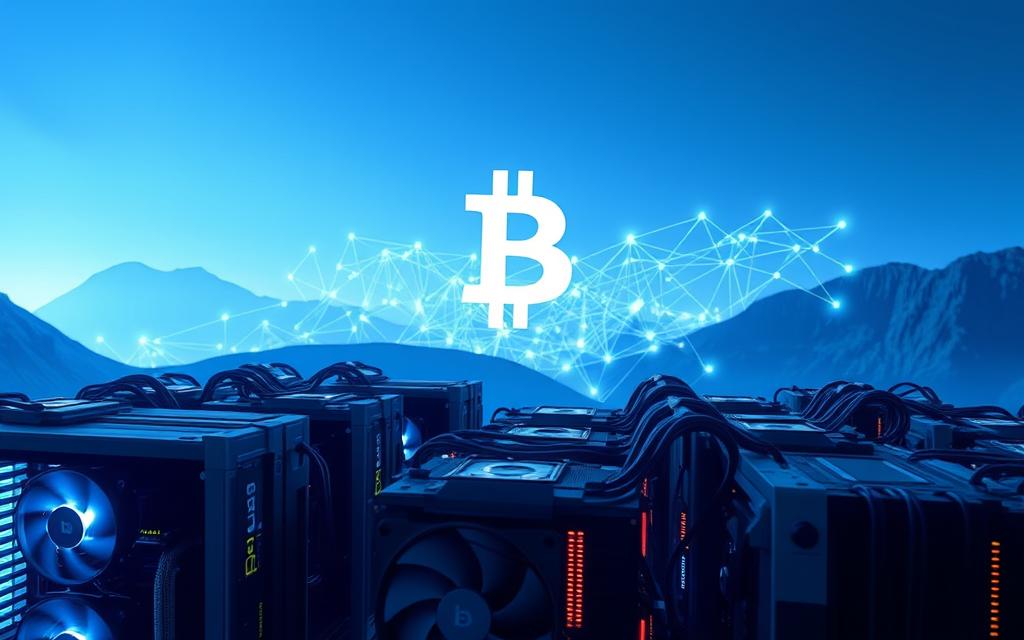
The Impact of Bitcoin Halving on Mining Time
Understanding the impact of Bitcoin halving on mining time requires a deep dive into its effects on mining profitability and network dynamics. Bitcoin’s creator, Satoshi Nakamoto, implemented the halving mechanism to create digital scarcity, mirroring the economic principles observed in gold mining.

What is Bitcoin Halving?
Bitcoin halving is a pre-programmed event that occurs approximately every four years, reducing the block reward for miners by 50%. This mechanism is designed to control inflation and maintain the value of Bitcoin by reducing the supply of new Bitcoins entering the market.
How Halving Affects Mining Profitability
The halving directly impacts miners’ revenue, effectively doubling the time needed to mine one Bitcoin in terms of rewards. Miners must adapt by improving efficiency and reducing costs to remain profitable. Historically, halvings have led to increased Bitcoin value, potentially offsetting reduced block rewards. However, the immediate effect is a significant reduction in mining profitability, forcing less efficient miners out of the market.
The economic theory behind halving, as explained by Satoshi Nakamoto, draws parallels with gold mining, where the marginal cost of production tends to approach the market price. This theory suggests that as the block reward decreases, the cost of mining will mirror the price of Bitcoin, influencing mining difficulty and hash rate over time.
- The reduction in block reward forces miners to rely more heavily on transaction fees, potentially increasing the value of Bitcoin due to reduced supply.
- Historically, the market has reacted positively to halvings, with price increases often following these events, though this is not guaranteed.
- Miners with access to cheaper electricity and more efficient hardware are better positioned to withstand the reduced profitability.
Bitcoin Mining Profitability Calculations
Bitcoin mining profitability is a multifaceted concept that depends on various factors, including hardware costs and electricity prices. Due to Bitcoin’s difficulty adjustment, the marginal cost of mining one bitcoin will forever approach the value of one bitcoin.
Electricity Costs and Mining Efficiency
Electricity costs play a significant role in determining mining profitability. Miners must consider not only the cost of electricity but also the efficiency of their mining hardware. The most efficient miners can significantly reduce their operational costs, thereby increasing their profitability. For instance, using modern ASIC miners can improve mining efficiency compared to older models.
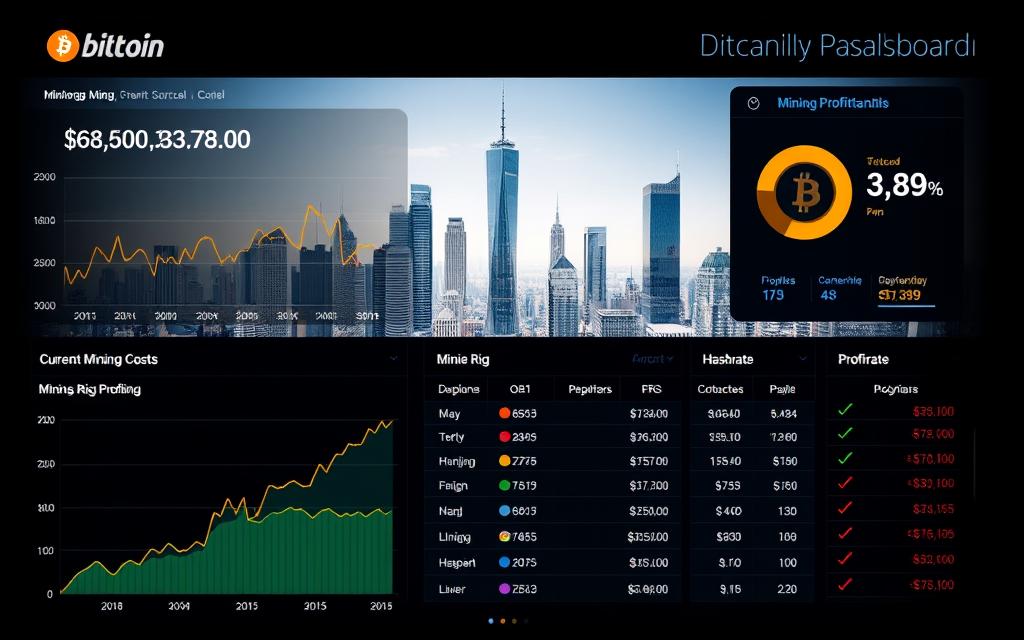
Calculating Your Break-Even Point
To calculate the break-even point for Bitcoin mining, one must consider several factors, including hardware costs, electricity expenses, mining pool fees, and maintenance costs. A comprehensive formula can help determine when a mining operation will recover its initial investment. For example, if the total cost of mining one bitcoin is $50,000 and the current price of bitcoin is $60,000, the mining operation is profitable. However, if the price drops to $40,000, the operation becomes unprofitable.
- Hardware costs and depreciation
- Electricity expenses and mining efficiency
- Mining pool fees and other operational costs
By understanding these factors and conducting thorough break-even analysis, miners can make informed decisions about their mining operations.
Conclusion: Is Bitcoin Mining Worth Your Time?
Having examined the various aspects that impact Bitcoin mining, we can now evaluate its potential as a worthwhile investment. For an individual miner using just one ASIC, mining one bitcoin would realistically take many years due to high competition and vast computational power required.
Mining pools offer a more viable option, allowing miners to combine their hash power and receive a portion of the bitcoin mined. However, the time it takes to mine a single bitcoin varies greatly depending on factors like network hash rate, mining difficulty, and hardware efficiency.
Ultimately, whether mining is worth your time depends on your specific circumstances, including electricity costs and the value you place on the potential rewards. It’s crucial to conduct thorough research and have realistic expectations before investing in this complex venture.
FAQ
What is the average time it takes to mine a single Bitcoin?
The average time to mine one Bitcoin is related to the block reward and the current mining difficulty. With a block time of around 10 minutes and a block reward of 6.25 BTC, it takes a substantial amount of computing power to mine a single Bitcoin.
How does the Bitcoin network hash rate affect mining time?
The network hash rate is a critical factor in determining mining time. A higher hash rate means more miners are competing, which can increase the time it takes to mine a Bitcoin. Conversely, a lower hash rate can make it easier to mine.
What is the role of mining difficulty in Bitcoin mining?
Mining difficulty adjusts every 2016 blocks, or approximately every two weeks, to maintain a consistent block time. As difficulty increases, it becomes harder to mine a Bitcoin, requiring more powerful hardware.
Can I mine a Bitcoin solo, or do I need to join a mining pool?
While solo mining is possible, the chances of successfully mining a Bitcoin are extremely low due to the high competition. Joining a mining pool increases your chances by combining your computing power with others.
How does Bitcoin halving impact mining profitability?
Bitcoin halving reduces the block reward by half, directly affecting mining profitability. Miners must adjust their strategies to remain profitable, often by upgrading their hardware or reducing energy costs.
What are the key factors to consider when calculating mining profitability?
To calculate mining profitability, consider factors such as electricity costs, mining hardware efficiency, and the current Bitcoin price. These elements help determine your break-even point and overall profitability.
How do ASIC miners compare to GPUs and CPUs in terms of mining performance?
ASIC miners are specifically designed for Bitcoin mining and offer significantly higher hash rates than GPUs and CPUs. They are the preferred choice for serious miners due to their efficiency and performance.
What is the impact of energy costs on Bitcoin mining profitability?
Energy costs are a significant expense for miners. High energy costs can erode profitability, making it essential to optimize mining operations and reduce energy consumption to remain competitive.


